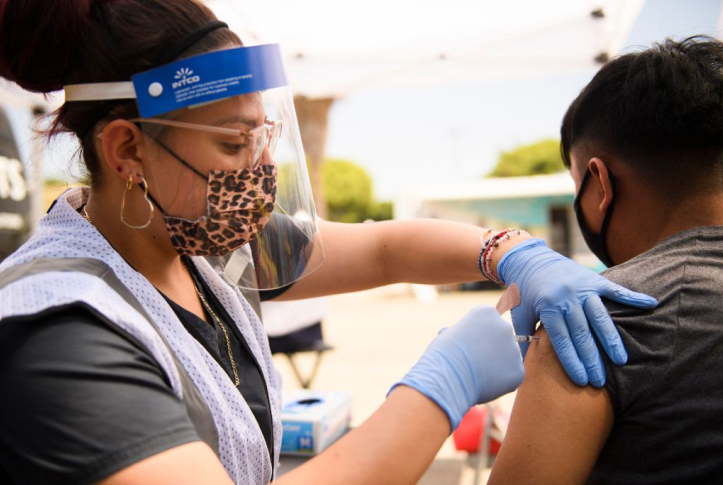Official approval of COVID-19 vaccines for children 5 to 11 has the potential to protect 28 million from getting sick and from spreading and harboring the virus. Evidence suggests vaccinating with speed and equity is the fastest route to recovery but doing so takes planning.
When demand for adult COVID-19 vaccination in the U.S. declined, leaders saw the need to engage trusted primary care providers (PCPs) in educating and motivating hesitant patients. PCPs, however, faced formidable financial and logistical barriers to delivering the vaccine while navigating workforce challenges and pent-up demand for primary care.
The Biden administration is taking a different approach to vaccinating younger children. The new plan includes offering the vaccine in 25,000 pediatric or primary care offices. Given that only 34 percent of parents say they plan to get their younger children vaccinated “right away” when they are eligible and more than 70 percent say the advice of their pediatrician will be an important factor in their decision, this plan holds great promise.
With a potential influx of newly eligible children in the coming weeks, states should address and reduce barriers to vaccination now, particularly leveraging trusted pediatricians. Here are five priorities states can consider:
Increase the number of pediatric providers offering COVID-19 vaccination and improve distribution.
The experience of vaccinating 12-to-17-year-olds suggests too few pediatricians or family practitioners are currently offering the vaccine. So far, only 48 percent of 12-to-17-year-olds are fully vaccinated; 58 percent have received one dose. The rate is increasing at about 1.5 percent per week across the country — its slowest yet — with trends varying significantly among states. The Standards for Pediatric Immunization Practices, established in May 1992 after a resurgence of measles, suggest that providers should educate parents and guardians on immunization at visits and have the vaccines on hand to simultaneously administer them. Referring patients off-site for vaccination can lead to missed opportunities.
Leaders can increase the number of pediatricians offering the COVID-19 vaccine by using the Vaccine Equity Planner to identify vaccine deserts — areas where access to vaccination is limited — and potential pediatric sites within them. States can then contact these providers directly to help facilitate engagement and address any barriers, which may include proper storage or workflow issues.
Increase financial resources and reimbursement for pediatric practices, especially for Medicaid patients.
Pediatric practices took a huge hit during the early stages of the pandemic when they were forced to reduce in-person patient visits and implement telemedicine. Reimbursements for COVID-19 vaccination are high relative to other services, but they are still low relative to what it takes for a practice to administer the complex vaccination effort during the pandemic. If demand is low because of vaccine hesitancy, the cost to convince patients and parents to vaccinate may be even higher. Adequate reimbursement will support providers in affording the staffing, space, and systems to oversee and track the recommended 15- or 30-minute observation periods after a vaccine is administered, which can help patients feel safe and protected and reinforce trust. States can consider reimbursing for vaccine education and outreach, even in the absence of achieving vaccination, or providing incentives for reaching certain speed and coverage milestones. Incentives from insurance companies to the highest-performing pediatricians for regular childhood immunizations have proven effective in motivating pediatricians to reach out and engage patients.
Encourage partnerships between health care and community-based organizations.
In line with the White House plan, states can collaborate with schools or community groups to augment and amplify vaccine education outside clinical offices and reinforce messaging. This tactic was successfully employed in Rhode Island as part of an initiative to administer HPV vaccines to protect adolescents. Upon seeing plateauing HPV vaccination rates, the Rhode Island Department of Health attained a Prevention and Public Health Fund cooperative agreement award with the Centers for Disease Control and Prevention (CDC) that enabled them to work closely with providers, schools, and the public. School nurses served as frontline public health advocates, and HPV vaccine orders and rates increased significantly. States and counties can leverage the billions of dollars of CDC funding provided through the American Rescue Plan Act and other legislation to support similar COVID-19 vaccine partnerships.
Provide technical support for vaccine reporting, data management, and logistics.
Clinics providing COVID-19 vaccines from state departments of public health must adhere to specific reporting requirements. However, their electronic medical records are not all seamlessly integrated with the state reporting systems, requiring additional data entry. Technical support from states to help make systems interoperable and support software integration will be valuable. States can leverage CDC COVID-19 vaccination funds to ensure clinics have appropriate patient communication, outreach, and tracking systems for scheduling to prevent missed doses and aid efforts.
Increase the number of eligible vaccinators who can staff pediatric offices.
Staffing shortages, sickness, and burnout have created human resource challenges. The Biden administration has given states increased flexibility through the Public Readiness and Emergency Preparedness Act to expand the types of providers that can administer vaccines, but state guidelines vary. States should consider allowing pharmacists, trainees, retired pediatricians, and other qualified professionals to vaccinate children. They also can help guide volunteers to pediatric practices to take burden from already-strained pediatric providers.
Trusted pediatricians and family practitioners can have a catalytic effect in the fight against COVID-19 by educating parents and administering the vaccine to children. Doing so will require support and coordination from states to optimize for speed, equity, and trust-building.








